

Unlike traditional NiMH AAs, Eneloops are a good choice for remote controls. With the approximately 0.1Ω resistance of the Eneloops, an 8A charge rate (which is needed to produce a 15 minute charge) would cause about 6.4W of heat to be generated in each cell, which will make them very hot. Although we use such chargers for R/C model power batteries, the cells in those batteries have a very low internal resistance (typically about 0.004Ω per cell) and can handle the high charge rates. Personally, I would steer away from the super-fast chargers that work in under an hour (some as fast as 15 minutes). ChargingĮneloop cells can be charged in any normal slow or fast charger designed for regular NiMH cells.

If it had waited until the cells “woke up”, it would probably have seen better results. The analyzer measures the resistance either immediately, or when the battery first drops below 1.2V per cell. This also accounts for the relatively high internal resistance reported by my battery analyzer. Here’s the graph of the discharge and charge after seven weeks:Įneloop cells can be charged in any standard Nickel Metal Hydride (NiMH) charger, including this do-it-yourself USB-powered one. Additional testing is required to determine this. Perhaps they’d do better stored at warmer temperatures, or maybe storing them in the freezer would be best. Sanyo doesn’t specify what the optimal storage conditions are for fully charged cells. Notice that the predicted six-month capacity matches very closely the capacity I measured on the six month old just-purchased cells. Even after one year, the Eneloops would still have half their rated capacity, whereas a regular NiMH battery would be virtually dead. These results are not as good as Sanyo’s claim of 90% charge retention over the course of six months, but still far better than what one would expect of ordinary NiMH cells. (Six month and one year values are predictions.) However, I wasn’t done testing yet, so on January 14, I cycled the original 4-pack a few times to make sure it was fully charged, after which it had the following characteristics:Ĭharge retention and loss characteristics ofĪA Eneloop cells for various periods of time. I also bought six more to use in my Nikon Coolpix 8700 camera (with the optional MB-E5700 battery pack designed to accept 6 NiMH cells). Self Dischargeīased on the results so far, I was sufficiently pleased with the Eneloops to start using them in my Garmin GPSMAP 60C, which sits for a week or two at a time in my flight bag, and then has to work for several hours when I take it flying. With a 400mA load, the voltage would have been 1.25V per cell. Once again the average voltage is less than the typical 1.2V per cell, but this is due to the high load. I chose a discharge rate of 1.2 Amps (1200mA), with the following results:įifth discharge/charge cycle of a 4-pack of AA Eneloop cells at 1.2A. I have a home-made computer-controlled battery charger/discharger/tester that I’ve used on my R/C batteries for years, so I used that to perform the tests.

The first thing I did after I purchased my Eneloops was to fully discharge them in order to measure their capacity. This means you can buy a pack because you need batteries now, use them, and then recharge them hundreds of times. Because of this, they can pre-charge them before packaging them up and expect them to still be close to fully charged by the time you buy them. Sanyo claims a low self-discharge rate of about 15% per year (compared with about 1% per day for regular NiMH offerings). They are also available in a kit with 8 AA and 4 AAA with a charger through Amazon. I immediately went to the nearest Circuit City store (called The Source here in Canada) and purchased a 4-pack of AA cells. In the R/C field, Sanyo has a long history of reliable and powerful cells, first Nickel Cadmium (NiCd) and more recently NiMH, so I was confident that their new Eneloop cells would be every bit as good as they claimed. My radio equipment uses AA sized cells and my planes are powered by high-discharge Sub-C sized cells. Normal NiMH AAs are available with capacities of up to 2700mAh nowadays, but when you consider self-discharge rate, such NiMH cells stored for about 30 days will drop to 2000mAh.Īs an avid radio controlled (R/C) model airplane enthusiast, I’ve been using rechargeable batteries for a long time. For the AA size, Sanyo claims a capacity of 2000mAh. One apparent disadvantage of the Eneloops over normal NiMH cells is lower capacity. Pre-Charged (Low Self-Discharge) Rechargeable Battery Comparison The results can be found in this article: I’ve obtained samples of many of them and done side-by-side comparison tests. Since the time this article was first published in early 2007, several other vendors have started offering low self-discharge AA NiMH batteries.


 0 kommentar(er)
0 kommentar(er)
